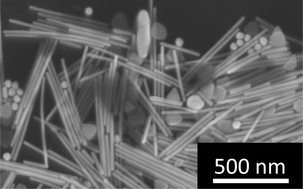Usage of the isotope effect for the synthesis of ultrahigh aspect ratio gold nanorods
Abstract
The synthesis of gold

* Corresponding authors
a
Laboratory for Nanometallurgy, Department of Materials, ETH Zurich, 8093 Zurich, Switzerland
E-mail:
susanne.koeppl@mat.ethz.ch
Fax: +41 44 632 11 01
Tel: +41 44 633 68 76
b
Polymer Technology, Department of Materials, ETH Zurich, 8093 Zurich, Switzerland
E-mail:
felix.koch@mat.ethz.ch
Fax: +41 44 632 1096
Tel: +41 44 632 61 76
c
Polymer Technology, Department of Materials, ETH Zurich, 8093 Zurich, Switzerland
E-mail:
walter.caseri@mat.ethz.ch
Fax: +41 44 632 1096
Tel: +41 44 632 22 18
d
Laboratory for Nanometallurgy, Department of Materials, ETH Zurich, 8093 Zurich, Switzerland
E-mail:
ralph.spolenak@mat.ethz.ch
Fax: +41 44 632 11 01
Tel: +41 44 632 25 90
The synthesis of gold

 Please wait while we load your content...
Something went wrong. Try again?
Please wait while we load your content...
Something went wrong. Try again?
S. Koeppl, F. P. V. Koch, W. Caseri and R. Spolenak, J. Mater. Chem., 2012, 22, 14594 DOI: 10.1039/C2JM30648D
To request permission to reproduce material from this article, please go to the Copyright Clearance Center request page.
If you are an author contributing to an RSC publication, you do not need to request permission provided correct acknowledgement is given.
If you are the author of this article, you do not need to request permission to reproduce figures and diagrams provided correct acknowledgement is given. If you want to reproduce the whole article in a third-party publication (excluding your thesis/dissertation for which permission is not required) please go to the Copyright Clearance Center request page.
Read more about how to correctly acknowledge RSC content.
 Fetching data from CrossRef.
Fetching data from CrossRef.
This may take some time to load.
Loading related content
